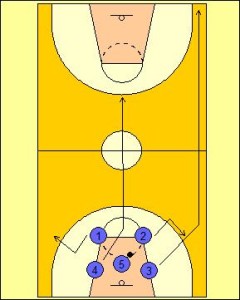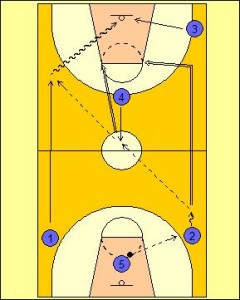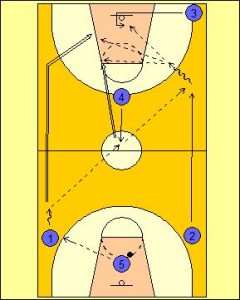Primary Transition: First Big Pivot
Having a solid Primary Transition is worth its weight in gold. A Primary Transition which presents a number of options like the First Big Pivot Play will help solve a number of problems most teams can experience when moving the ball with purpose up the floor.

The Primary Transition First Big Pivot Play looks to switch the side down which the ball is progressed. The strength of the offense is in pushing a number of players ahead of the ball to create a significant advantage.
For ease of depiction, the Primary Transition has been diagrammed out of a 2-3 Zone Formation.
The Guards (One and Two) create leads for the ball.
The non-rebounding big (Four) sprints along the middle lane not stopping until reaching the three-point line on the offensive end of the floor.
The Three (3) player looks to sprint down the nearest sideline and finish at the double block extended. It does not matter on which side this player moves as both options will be discussed later on in the play variations.
Three’s (3) key role at this stage of the primary transition is just to extend the defensive players and make them guard a player in the full court to help expose passing lanes.
As with all primary transition offenses, it is far better for a long outlet to occur then a shallow pass to be made to one of the guards (One and Two).

Overload Outlet Variation
In this option, the ball is outleted to the same side of the floor as the Three (3) player.
Five (5) outlets the ball to Two (2).
Two (2) can use a maximum of one dribble before attempting to make a pass. This ensures a quick advancement of the ball and puts bodies in motion towards the offensive end of the floor.
While the ball is being passed the first big over halfway bounces from the three-point line back towards halfway.
Two (2) looks to execute a pass to Four (4) off of bouncing back towards the ball. If this pass is not available then the alternative option is for a long pass the be made to Three (3) down the sideline.
Two (2) looks to follow the sideline and finish after the drive by One (1) in a receiver spot on the weak side elbow.
Four (4) looks to pass to the guard who did not receive the outlet pass effectively changing the side of the floor the ball is being passed down.
After making the pass to One (1), Four (4) should pause and wait for the drive to the basket to happen. When One (1) advances the ball towards the hoop Four (4) will flash to the strong side elbow and fill the role as a receiver.
Once One (1) receives the pass from Four (4) the player will look to attack the basket as soon as possible.
As One (1) initiates the drive to the basket Three (3) should look to flash to the receiver spot at the weak side low post.

Isolation Outlet Variation
In this option, the ball is outleted to the opposite side of the floor as the Three (3) player.
Five (5) outlets the ball to One (1).
Again, ensure the guards are aware they can only take a maximum of one dribble before passing the ball.
Four (4) looks to lift and receiver a pass from One (1) this time. As four starts to lift Three (3) flashes to the basket to seal into an interior target position on the rim.
Once One (1) makes the pass, the player continues down the sideline before filling a weak side mid-range shooting position.
Four (4) reverses the ball to Two (2) who is the weak side guard that did not receive the outlet pass.
Following the pass Four (4) dives to the weak side high post.
Two (2) now has a number of options to look for in scoring:
- Quick post entry pass into Three (3)
- Drive to the keyway for an interior jump shot
- Drive and draw the defence for a pass to either Four (4) or One (1)
In both variations Five (5) trails the primary transition to finish outside the three-point line in the point position.







